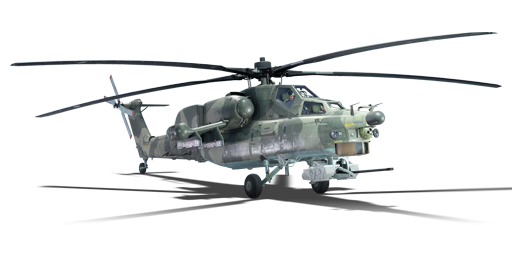




The Mi-28N (NATO Code: Havoc) is a Russian attack helicopter designed with the intent of overcoming the limitations found in its predecessor, the Mi-24. It was developed in the 2000s and entered service with the Russian military in 2009. While the Hind can be considered a "flying IFV" combining armament and troop transport capability, the Havoc mostly abandons the latter in order to become a dedicated attack helicopter. It maintains the Mil Mi tradition of heavy weight, strong armour protection (by helicopter standards), and inelegant looks, but without the volume required to ferry troops, the airframe does not feel as bulky in flight.
The Mi-28N was introduced in Update 1.93 "Shark Attack". Its suspended ordnance is almost the same as the preceding Mi-35M, relying mostly on Ataka ATGMs and unguided rockets for tank busting and Igla MANPADS for air defence, but it is capable of carrying two times as many ATGMs. The cherry on the top is the massive chin turret carrying a 30 mm 2A42 autocannon, the same model used by the BMP-2, with wide firing angles, APDS rounds, and an auto-tracker. Although sniping tanks with ATGMs is much safer in the face of enemy SAMs, pilots brave enough to bring the Mi-28N into close combat can indeed wreak havoc on unsuspecting opponents.
| Belt | Belt filling | Armor penetration (mm) at a distance: | |||||
|---|---|---|---|---|---|---|---|
| 10 m | 100 m | 500 m | 1000 m | 1500 m | 2000 m | ||
| AP-T/HEF-I | 65 | 63 | 53 | 44 | 36 | 29 | |
| APDS/AP-T/HEF-I/HEF-I | 82 | 81 | 79 | 75 | 72 | 69 | |
| APDS | 82 | 81 | 79 | 75 | 72 | 69 | |
| HEF-T/AP-T/HEF-I/HEF-I | 65 | 63 | 53 | 44 | 36 | 29 | |
| Name | Weight | Slot | ||||
|---|---|---|---|---|---|---|
| 4 × | 42.4 kg |  |  | |||
| 20 × | 326 kg |  |  |  |  | |
| 5 × | 505 kg |  |  |  |  | |
| 4 × | 195.6 kg |  |  | |||
| 8 × | 391.2 kg |  |  | |||
| 163.8 kg |  |  | ||||












Flight performance |
|---|
Survivability |
|---|
Weaponry | ||
|---|---|---|